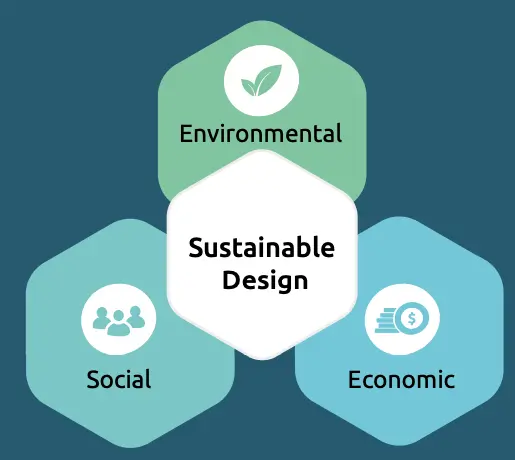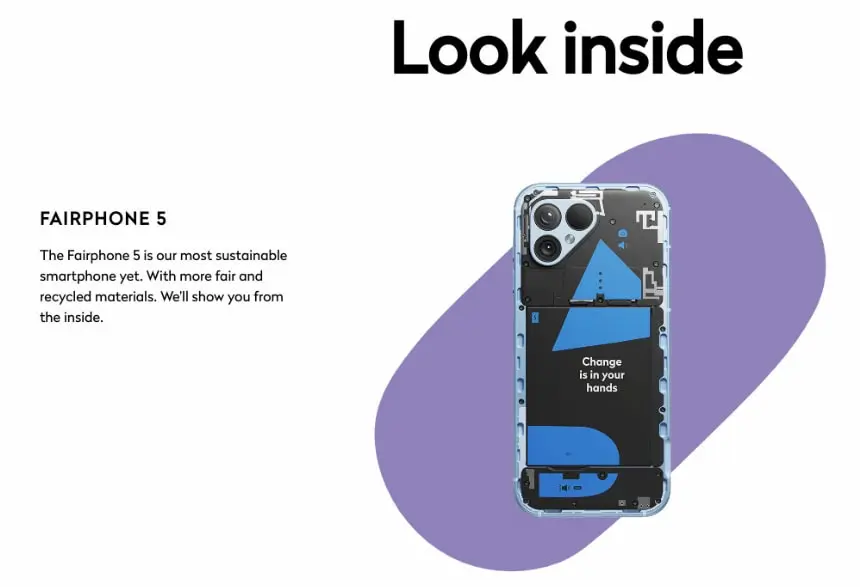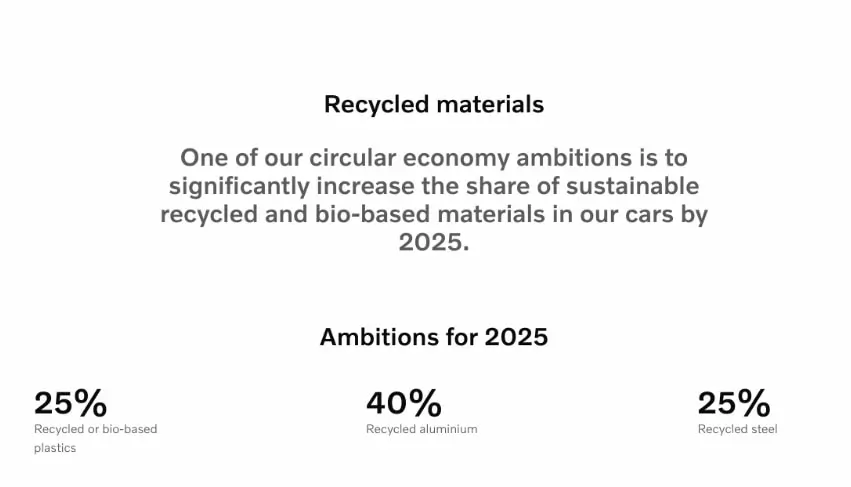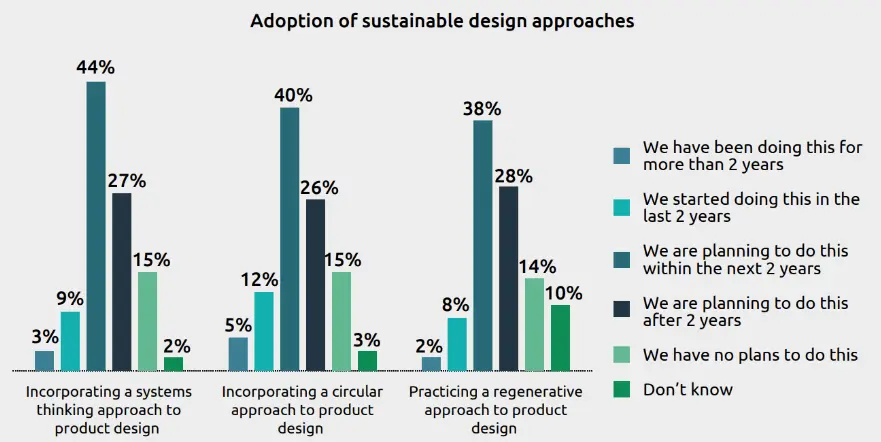“Climate change is a major threat to my country.”
The decade from 2013 to 2022 saw a huge increase in the number of people around the world who agreed with this statement, according to data from the Pew Research Center.
A consequence of this global trend of environmental awareness is that the concept of sustainability has received more and more attention, particularly around sustainable product design.
But what exactly is sustainable product design, and what are the principles a designer should know?
I’ve written this guide to sustainable product design to answer these questions and more.
- What is sustainable product design?
- 7 sustainable product design practices
- Sustainable product design examples
- Why is sustainable product design so important?
- Why are corporations moving to sustainable product design?
- Final thoughts
What is sustainable product design?
Sustainable product design is forward-thinking and has a long-term perspective at its core. The primary goal of sustainable product design is to have a positive impact on people, the planet, and profits.
To achieve this, sustainable product design has to incorporate three potential impact areas:
- Environmental impact
- Social impact
- Economic impact
The Capgemini Research Institute defines sustainable design “maximizing environmental, social, and economic benefits over a system’s lifecycle, while minimizing associated social and environmental costs.”

This is a useful visualization as it represents the three impacts that sustainable product design has to balance.
But these three concepts don’t just have to be viewed just as the impacts of sustainable product design—they can also be viewed as the driving forces behind it. There are now strong environmental, social, and economic pressures on many global corporations to design products that are sustainable.
Now let’s look at the actual practices that make up sustainable product design.
7 sustainable product design practices
While the terms and their nuances can vary significantly by industry and region, there are several broad practices that are applicable in most industries.
Here are seven of the most important sustainable product design practices—terms every product designer should know:
1. Circularity, circular economy, or circular design thinking
This practice can have slightly different meanings in different contexts, but it’s essentially about designing products for durability, reuse, recycling, and repairability (sometimes through modularity, which allows customers to easily repair or replace a single components instead of replacing the whole product). It also includes designing for disassembly and end-life-collection. All of this serves the purpose of maximizing resources. It’s the opposite of a linear economy, where you use a raw material, build a product, use it, and then throw it out as waste.
2. Dematerialization
Dematerialization is the practice of using fewer materials in both the product and packaging. Lightweight products take less resources to produce, less energy to operate, and are easier to transport. All of this helps with sustainability.
3. Product efficiency
This refers to designing products which use the minimum possible amount of energy. This includes designing for both energy consumption efficiency—this is the best way to reduce carbon footprint during use, which is when most emissions occur—and material consumption efficiency.
4. Next-best materials selection
Material selection is a huge component of how sustainable or unsustainable any product is. Next-best material selection refers to selection of materials that minimize their product’s environmental impact, without reducing functionality. This includes options like biodegradable, recycled, recyclable, or lightweight materials. Next-best materials selection can also reduce a product’s weight, which often reduces energy consumption.
5. Green supply chain
Creating a green supply chain includes selecting materials, parts, and components that reduce the environmental impact of logistics and products. Corporations can also design products that are compatible with simple, low-energy logistics, and move towards more frugal processes and operations.
6. Regenerative approach
Probably one of the more niche sustainable product design best practices, a regenerative approach is one where corporations create products that renew or replenish systems, instead of depleting them. One example of this is using materials that sequester carbon from the atmosphere.
7. Systems thinking
This approach fosters sustainability by looking beyond isolated design problems and considering the broader system in which the product exists. Doing this during the design phase is a way to consider a product’s social and environmental impacts across its entire lifecycle.
Sustainable product design examples
We’ve covered a lot of the theoretical ground so far, now let’s take a look at three examples of sustainable product design at corporations.
Example 1: Fairphone
Fairphone is a Dutch company established in 2013 that designs and manufactures smartphones and headphones. Fairphone describes their mission as “working step by step to bring sustainability and fair labor practices into focus in the electronics industry”.
Their latest offering, the Fairphone 5, contains more than 70% fair and recycled materials. They have also taken steps to create supply chain transparency, openly sharing that information on their website.
 They’re focused on designing and building phones from responsibly sourced materials, and making them both long-lasting as well as easy to repair and recycle. As part of their mission to put people and the environment first, they’re also committed to human rights and worker wellbeing.
They’re focused on designing and building phones from responsibly sourced materials, and making them both long-lasting as well as easy to repair and recycle. As part of their mission to put people and the environment first, they’re also committed to human rights and worker wellbeing.
They’ve been awarded a platinum Ecovadis medal for being in the top 1% of sustainable companies in their industry. They’re also the only smartphone company that has been Fairtrade gold certified because of their use of responsibly sourced materials.
You can see some hallmarks of the sustainable product design practice of circularity in Fairphones:
- Modular design, which means customers can often easily replace or repair a single component by themselves
- Built to be durable and long-lasting—the company offers a five year guarantee on the Fairphone 5 and it will be supported for 10 years
Interestingly, one of Fairphone’s founders, Bas van Abel, has admitted that it’s not possible to produce a 100% fair phone, instead saying describing their phones as “fairer” might be more accurate.
Example 2: On
Impressively, Swiss sports-shoe company On has developed a fully recyclable shoe made from bio-based synthetic materials. And instead of a conventional sales model, On has created a subscription model called Cyclon, which offers their customers “fully recyclable running shoes”. It lets them send their shoes back to the manufacturer for disassembly after 6 months (or longer)—they’ll then receive a new pair in return. All for free (though On is a premium brand). But what does On do with the old pair? They “wash and grind down the materials” until they’re “ready to be transformed into new components”.

But what does On do with the old pair? They “wash and grind down the materials” until they’re “ready to be transformed into new components”.
Example 3: Volvo Cars
Our third example of sustainable product design is Volvo Cars. I’ve chosen them because they’re a huge global corporation operating in an industry that is probably as central to the climate crisis than any other: car manufacturing.
Volvo has lofty ambitions for sustainability, and it remains to be seen which of them they can achieve. But credit where it’s due—they’ve already made solid progress on some fronts by following sustainable product design practices.
In 2022, they saved over 4,800 tons of CO2 by remanufacturing more than 33,000 parts, including engines, gearboxes, turbo compressors, and clutches. These parts use around 85% less raw material and around 80% less energy.

Volvo has publicly committed to becoming a circular business by 2040. They’re determined to eliminate waste, make greater use of recycled material, and remanufacturing and reusing parts. They’re now bringing considerations about their vehicles’ entire life-cycles into the design stage and figuring out how “the disassembly and recycling process can provide high quality and quantity raw materials”.
Why is sustainable product design so important?
Achieving both sustainability and net-zero emissions are crucial factors if we are to halt—and eventually reverse—the climate disaster we’re watching unfold.
With half of global greenhouse gas (GHG) emissions and 90% of biodiversity loss being attributed to extraction and processing of primary raw materials, any sustainable product design that results in dematerialization can make direct and immediate impact.
The global environmental argument is as simple as it is irrefutable. But, while this may be true, why would any individual corporation feel compelled to move sustainable product design?
I’ll try to answer that question now.
Why are corporations moving to sustainable product design?
It’s worth being clear on the fact that many corporations aren’t, in fact, engaging with sustainable product design in any kind of meaningful way.
In their report, the Capgemini Research Institute surveyed 900 senior product design and engineering executives from corporations across industries, including “consumer products, automotive, industrial manufacturing, aerospace and defense, high-tech, and medical devices”.
Their results show that the vast majority of the 900 corporations surveyed have not adopted any of the three sustainable design approaches they were asked about:
- Systems thinking to foster sustainability
- 12% of corporations are doing this
- 71% have plans to do this at some point
- 17% don’t plan to do this or don’t know
- Circular design thinking
- 17% of corporations are doing this
- 66% have plans to do this at some point
- 18% don’t plan to do this or don’t know
- Regenerative approaches
- 10% of corporations are doing this
- 66% have plans to do this at some poin
- 24% don’t plan to do this or don’t know

Let’s look at why some corporations are engaging with sustainable product design.
There are several factors pushing companies to move to sustainable product design. Three of the largest factors are:
- Tightening regulations: The EU, as well as many national governments, is pushing for and enacting regulations to increase sustainability. This includes initiatives like the use of recycled content in products or packaging, which the European Commission has proposed minimum targets for in EV batteries. The Net-Zero Industry Act is another initiative out of the EU, which was seen by many as a response to the U.S.’s plan to plan to funnel $369 billion into their green tech industry as part of the Inflation Reduction Act (IRA).
- Shifting customer preferences: With as many as 62% of consumers now saying they’re willing to change their purchasing behavior to help reduce negative impacts on the environment, corporations that ignore their customers’ values are in danger of being left behind. Not only is understanding what consumers value critical to economic success, corporations that look like they’re ignoring the climate disaster are risking their brand. This applies doubly to those corporations whose target audience is younger, as recent research from Cardiff University in Wales has shown that Millennials and Gen-Z have higher rates of climate worry.
- Pressure from investors: As the global trend towards sustainability has increased, corporations that are reliant on investors have started to feel pressure from them to embrace sustainable product design. Large hedge funds may be wary of brand damage by association if they invest their capital in corporations which don’t seem concerned by the climate crisis. According to the Capgemini Research Institute report, 75% of corporations who have implemented at least one sustainable product design strategy said they’d seen an increased ability to attract capital. We’ve now reached a point where investing in sustainable product design can actually help drive sales as well as attract investment.
Now that we’ve explored why sustainable product design is important from both a global and corporate perspective, let’s look at three examples of sustainable product design in action.
Final thoughts
While sustainable product design is a huge priority for many corporations, even more have yet to put their plans into any real action. Even worse, a good chunk of them have no plans to do so at all.
But, with global awareness and acknowledgement of the climate crisis growing year on year, many of these companies will be under extreme pressure to become more sustainable from their customers, their investors, and tightening regulations.
And, with an estimated 80% of products’ environmental impacts coming from decisions made at design stage, sustainable product design will become a business imperative for more and more corporations.
With awareness of the core principles of sustainable product design, one can start to go deeper into the applications for a particular industry or product.
Interested in product design? Check out our free 5-day product design course, or read any of these related guides:
